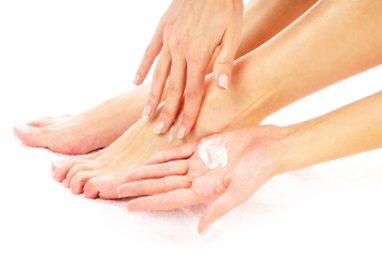3 ways to fight foot fungus
Soothe the sting of athlete’s foot with these fungus-fighting remedies

Source: Best Health Magazine, March/April 2011
Don’t let the name fool you’athletes aren’t the only ones who pick up the contagious condition known as athlete’s foot. According to Roy Mathews, a Vancouver-based podiatrist, up to 70 percent of Canadians will experience it at some point, meaning it’s just as common (if not more so) as dandruff, which is also caused by fungi.
The culprit behind athlete’s foot is Trichophyton rubrum, a fungus that grows in warm, dark, moist and poorly ventilated environments and feeds on the outer dead layer of skin. It’s transmitted through direct contact with an infected person or from touching contaminated surfaces such as the floors of public showers, locker rooms and pools. In the winter, it can thrive: Socks and shoes (especially ones made from synthetic materials) can trap moisture, creating an ideal breeding ground.
Because excess moisture is most likely to collect between the toes, that’s where symptoms usually appear, although they can be on the soles of the feet, too. Redness, peeling and flaking are the first signs; as the condition progresses, sufferers can experience itching, stinging, burning and even blisters. Left untreated, the condition can not only lead to a deeper fungal infection, but can also cause secondary bacterial infections in the feet as well as other parts of the body.
If you suspect you have athlete’s foot and also have a compromised immune system (such as diabetes or AIDS), see a doctor for treatment. You should also get medical help if your feet are in pain, severely inflamed or weeping; have open sores; or if a toenail appears thickened or discoloured. Otherwise, ‘treat any outbreak right away with an over-the-counter antifungal, and use it for two weeks straight,’ says Mathews. Try one of these solutions to fight the infection and soothe symptoms.
To clear up infection
Examples: Micatin Antifungal Cream, Lotrimin AF For Her Athlete’s Foot Cream and Flexitol Medicated Foot Cream
How they work: Clotrimazole (found in Lotrimin), miconazole (in Micatin) and tolnaftate (in Flexitol) have all been shown to be effective in the management of fungal infections of the skin. These antifungal agents work by inhibiting the fungus’s ability to synthesize ergosterol, a type of sterol that forms an essential component of the fungal cell membrane.
Need to know: Use topical antifungal medications twice daily on clean, dry feet as soon as symptoms appear, and continue treatment for two weeks. Since the infection can spread, make sure to apply the cream or ointment one or two inches (3-5 cm) beyond the affected area. Although these treatments are usually well tolerated, minor burning, stinging or, rarely, local allergic reactions may occur.
To keep feet dry
Examples: Zeasorb-AF Super Absorbent Antifungal Powder, Dr. Scholl’s Athlete’s Foot Powder and Tinactin Super Absorbent Powder
How they work: These medicated powders not only help keep feet dry, but also treat the infection with the antifungal ingredients miconazole (found in Zeasorb) and tolnaftate (in Dr. Scholl’s and Tinactin). ‘They can be useful, especially if the infection is wet,’ says Bryce Wong, a Vancouver-based pharmacist.
Need to know: ‘I like medicated powders for people who have recurrent infections because they can be used to prevent, as well as treat, the problem,’ says Mathews. Use them twice daily on clean, dry feet; then put on socks. Avoid baby powder and powders with menthol on athlete’s foot’they’re ineffective, and the latter may cause tingling. As with the creams and ointments, side effects from medicated powders are rare but may include minor burning, stinging or local allergic reactions.
To treat symptoms
Examples: PediFix FungaSoap, Buro-Sol Antiseptic Powder and Johnson’s Foot Soap
How they work: Buro-Sol, a soothing and cooling foot soak that you mix with water, contains the drying agents aluminum acetate and benzethonium chloride, which remove moisture from the skin to help decrease the growth of the fungus. Johnson’s Foot Soap, another soak, contains borax and iodide to calm itching and burning, while PediFix, a cleansing wash with tea tree oil, helps relieve itching and dryness.
Need to know: Avoid foot soaks if you have broken skin, as bacteria can spread through open wounds. Since these products only treat symptoms, use them in conjunction with medicated creams, ointments or powders. ‘Symptoms can resolve as early as one week after starting antifungal treatment [such as with the examples of creams listed under ‘To Clear Up Infection’], so you can stop using these symptomatic remedies at that time,’ says Wong.
This article was originally titled "Sole Mates," in the March/April 2011 issue of Best Health. Subscribe to Best Health today and never miss an issue!




